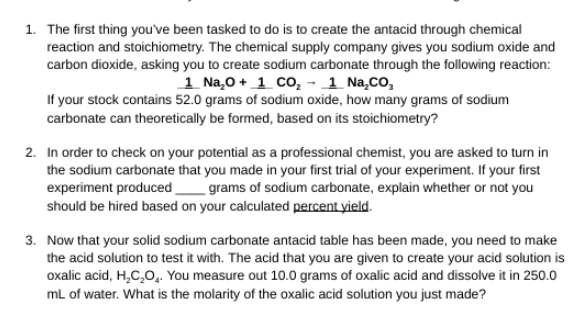3. Now that your solid sodium carbonate antacid table has been made, you need to make the acid solution to test it with. The acid that you are given to create your acid solution is oxalic acid, H,C,o.. You measure out 10.0 grams of oxalic acid and dissolve it in 250.0 mL of water. What is the molarity of the oxalic acid solution you just made?
3. Now that your solid sodium carbonate antacid table has been made, you need to make the acid solution to test it with. The acid that you are given to create your acid solution is oxalic acid, H,C,o.. You measure out 10.0 grams of oxalic acid and dissolve it in 250.0 mL of water. What is the molarity of the oxalic acid solution you just made?
Chemistry for Engineering Students
4th Edition
ISBN:9781337398909
Author:Lawrence S. Brown, Tom Holme
Publisher:Lawrence S. Brown, Tom Holme
Chapter4: Stoichiometry
Section: Chapter Questions
Problem 4.68PAE: 4.68 The pictures below show a molecular-scale view of a chemical reaction between the compounds AB2...
Related questions
Question
3

Transcribed Image Text:1. The first thing you've been tasked to do is to create the antacid through chemical
reaction and stoichiometry. The chemical supply company gives you sodium oxide and
carbon dioxide, asking you to create sodium carbonate through the following reaction:
1 Na,0 + 1 CO, - 1 Na,Co,
If your stock contains 52.0 grams of sodium oxide, how many grams of sodium
carbonate can theoretically be formed, based on its stoichiometry?
2. In order to check on your potential as a professional chemist, you are asked to turn in
the sodium carbonate that you made in your first trial of your experiment. If your first
experiment produced
should be hired based on your calculated percent yield.
grams of sodium carbonate, explain whether or not you
3. Now that your solid sodium carbonate antacid table has been made, you need to make
the acid solution to test it with. The acid that you are given to create your acid solution is
oxalic acid, H,C,O,. You measure out 10.0 grams of oxalic acid and dissolve it in 250.0
mL of water. What is the molarity of the oxalic acid solution you just made?
Expert Solution
This question has been solved!
Explore an expertly crafted, step-by-step solution for a thorough understanding of key concepts.
Step by step
Solved in 2 steps with 2 images

Knowledge Booster
Learn more about
Need a deep-dive on the concept behind this application? Look no further. Learn more about this topic, chemistry and related others by exploring similar questions and additional content below.Recommended textbooks for you

Chemistry for Engineering Students
Chemistry
ISBN:
9781337398909
Author:
Lawrence S. Brown, Tom Holme
Publisher:
Cengage Learning

Chemistry for Engineering Students
Chemistry
ISBN:
9781285199023
Author:
Lawrence S. Brown, Tom Holme
Publisher:
Cengage Learning

Chemistry: Principles and Practice
Chemistry
ISBN:
9780534420123
Author:
Daniel L. Reger, Scott R. Goode, David W. Ball, Edward Mercer
Publisher:
Cengage Learning

Chemistry for Engineering Students
Chemistry
ISBN:
9781337398909
Author:
Lawrence S. Brown, Tom Holme
Publisher:
Cengage Learning

Chemistry for Engineering Students
Chemistry
ISBN:
9781285199023
Author:
Lawrence S. Brown, Tom Holme
Publisher:
Cengage Learning

Chemistry: Principles and Practice
Chemistry
ISBN:
9780534420123
Author:
Daniel L. Reger, Scott R. Goode, David W. Ball, Edward Mercer
Publisher:
Cengage Learning


Chemistry: An Atoms First Approach
Chemistry
ISBN:
9781305079243
Author:
Steven S. Zumdahl, Susan A. Zumdahl
Publisher:
Cengage Learning

Chemistry
Chemistry
ISBN:
9781305957404
Author:
Steven S. Zumdahl, Susan A. Zumdahl, Donald J. DeCoste
Publisher:
Cengage Learning